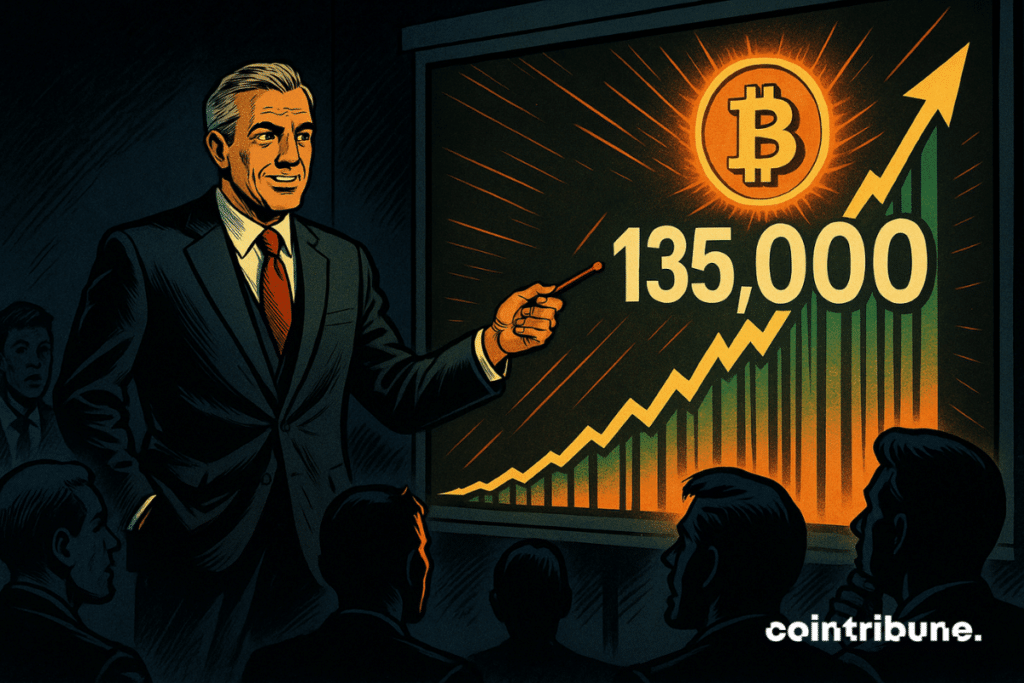Bitcoin No Longer Follows The Old Halving Model
While financial markets waver under the weight of monetary uncertainties and political tensions, a bold projection revives the debate. Bitcoin could reach $135,000, according to Standard Chartered. In a recent note, the British bank disrupts established scenarios by stating that the current market dynamics invalidate historical post-halving patterns. This change of tone, coming from a major player in traditional finance, revitalizes bullish expectations as BTC enters a new phase of acceleration.

In Brief
- Standard Chartered expects Bitcoin could reach $135,000 very soon, even $200,000 by the end of 2025.
- The bank challenges a historical cyclical model that predicted a post-halving drop.
- Contrary to expectations, Bitcoin remains above $120,000 after the April 2024 halving.
- This dynamic fits within a seasonal bullish trend nicknamed ‘Uptober’.
A Historical Model Disrupted According to Standard Chartered
In a shared note, Geoff Kendrick, global head of crypto research at Standard Chartered, questions one of the most entrenched cyclical patterns in crypto market analysis: the drop in bitcoin prices 18 months after a halving.
“Bitcoin has departed from a pattern that, until now, saw prices fall 18 months after the halving”, he observes. However, this cycle should have, according to this logic, triggered a notable retreat by this year’s end, following the April 2024 halving. This is evidently not the case. Bitcoin remains strong, even accelerating, breaking through the $120,000 mark this week.
This dynamic seems to confirm that the crypto market is escaping its old structural benchmarks. To support this idea, several factual elements reinforce the thesis of a new post-halving paradigm :
- Bitcoin currently trades at $120,606, up 1.71 % over 24 hours ;
- The price already reached $120,286 the day before, marking a nearly 8 % increase over the week ;
- This rise fits into a trend nicknamed “Uptober”, well known among observers for its typical bullish momentum in the last quarter.
Kendrick points out that this trajectory is unprecedented compared to the post-halving cycle observed in 2018–2019, where the market remained inert despite a U.S. government shutdown similar to the current one.
Massive Flows into Bitcoin ETFs
Beyond cyclical considerations, Standard Chartered highlights a fundamental element in the current bitcoin rise: institutional demand. In his note, Geoff Kendrick specifies that net inflows into Bitcoin ETFs now reach $58 billion, including $23 billion generated in 2025 alone.
He states : “I anticipate at least an additional $20 billion by year-end, an amount that would make my forecast of $200,000 for bitcoin at that deadline possible”. The analyst thus suggests that the current dynamic could not only lead to a peak of $135,000 but potentially to $200,000 by the end of the year, should the flows continue.
Looking ahead, several implications can be considered. First, this rise in institutional participants could contribute to reducing bitcoin’s historical volatility while increasing its correlation with global macroeconomic indicators. Next, the increase in flows toward ETFs fuels a form of financial legitimization of BTC, likely to attract capital still on the fringes of the crypto market in this thrilling year-end.
Maximize your Cointribune experience with our "Read to Earn" program! For every article you read, earn points and access exclusive rewards. Sign up now and start earning benefits.
Diplômé de Sciences Po Toulouse et titulaire d'une certification consultant blockchain délivrée par Alyra, j'ai rejoint l'aventure Cointribune en 2019. Convaincu du potentiel de la blockchain pour transformer de nombreux secteurs de l'économie, j'ai pris l'engagement de sensibiliser et d'informer le grand public sur cet écosystème en constante évolution. Mon objectif est de permettre à chacun de mieux comprendre la blockchain et de saisir les opportunités qu'elle offre. Je m'efforce chaque jour de fournir une analyse objective de l'actualité, de décrypter les tendances du marché, de relayer les dernières innovations technologiques et de mettre en perspective les enjeux économiques et sociétaux de cette révolution en marche.
The views, thoughts, and opinions expressed in this article belong solely to the author, and should not be taken as investment advice. Do your own research before taking any investment decisions.